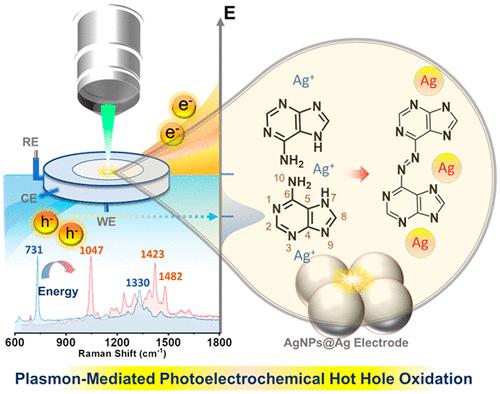当前位置:
X-MOL 学术
›
J. Phys. Chem. Lett.
›
论文详情
Our official English website, www.x-mol.net, welcomes your feedback! (Note: you will need to create a separate account there.)
Plasmon-Mediated Photoelectrochemical Hot-Hole Oxidation Coupling Reactions of Adenine on Nanostructured Silver Electrodes
The Journal of Physical Chemistry Letters ( IF 5.7 ) Pub Date : 2023-05-30 , DOI: 10.1021/acs.jpclett.3c00619 Ya-Qiong Su 1, 2 , Jia Liu 1, 3 , Rong Huang 1 , Hong-Tao Yang 1 , Ming-Xue Li 1 , Ran Pang 1 , Meng Zhang 1 , Meng-Han Yang 1 , Hai-Feng Su 1 , Rajkumar Devasenathipathy 1 , Yuan-Fei Wu 1 , Jian-Zhang Zhou 1 , De-Yin Wu 1 , Su-Yuan Xie 1 , Bing-Wei Mao 1 , Zhong-Qun Tian 1
The Journal of Physical Chemistry Letters ( IF 5.7 ) Pub Date : 2023-05-30 , DOI: 10.1021/acs.jpclett.3c00619 Ya-Qiong Su 1, 2 , Jia Liu 1, 3 , Rong Huang 1 , Hong-Tao Yang 1 , Ming-Xue Li 1 , Ran Pang 1 , Meng Zhang 1 , Meng-Han Yang 1 , Hai-Feng Su 1 , Rajkumar Devasenathipathy 1 , Yuan-Fei Wu 1 , Jian-Zhang Zhou 1 , De-Yin Wu 1 , Su-Yuan Xie 1 , Bing-Wei Mao 1 , Zhong-Qun Tian 1
Affiliation

|
Surface-enhanced Raman spectroscopy (SERS) has been widely applied in the identification and characterization of DNA structures with high efficiency. Especially, the SERS signals of the adenine group have exhibited high detection sensitivity in several biomolecular systems. However, there is still no unanimous conclusion regarding the interpretation of some special kinds of SERS signals of adenine and its derivatives on silver colloids and electrodes. This Letter presents a new photochemical azo coupling reaction for adenyl residues, in which the adenine is selectively oxidized to (E)-1,2-di(7H-purin-6-yl) diazene (azopurine) in the presence of silver ions, silver colloids, and electrodes of nanostructures under visible light irradiation. The product, azopurine, is first found to be responsible for the SERS signals. This photoelectrochemical oxidative coupling reaction of adenine and its derivatives is promoted by plasmon-mediated hot holes and is regulated by positive potentials and pH of solutions, which opens up new avenues for studying azo coupling in the photoelectrochemistry of adenine-containing biomolecules on electrode surfaces of plasmonic metal nanostructures.
中文翻译:

腺嘌呤在纳米结构银电极上的等离子体介导的光电化学热孔氧化耦合反应
表面增强拉曼光谱 (SERS) 已广泛应用于 DNA 结构的高效鉴定和表征。特别是,腺嘌呤基团的 SERS 信号在多种生物分子系统中表现出高检测灵敏度。然而,对于腺嘌呤及其衍生物在银胶体和电极上的某些特殊SERS信号的解释,目前还没有统一的结论。This Letter 介绍了一种新的腺苷残基光化学偶氮偶联反应,其中腺嘌呤被选择性氧化为 ( E )-1,2-di(7 H-purin-6-yl) diazene (azopurine) 在可见光照射下存在银离子、银胶体和纳米结构电极的情况下。首次发现产物偶氮嘌呤负责产生 SERS 信号。腺嘌呤及其衍生物的这种光电化学氧化偶联反应由等离子体介导的热空穴促进,并受正电位和溶液 pH 值的调节,为研究含腺嘌呤生物分子在电极表面的光电化学中的偶氮偶联开辟了新途径。等离子体金属纳米结构。
更新日期:2023-05-30
中文翻译:

腺嘌呤在纳米结构银电极上的等离子体介导的光电化学热孔氧化耦合反应
表面增强拉曼光谱 (SERS) 已广泛应用于 DNA 结构的高效鉴定和表征。特别是,腺嘌呤基团的 SERS 信号在多种生物分子系统中表现出高检测灵敏度。然而,对于腺嘌呤及其衍生物在银胶体和电极上的某些特殊SERS信号的解释,目前还没有统一的结论。This Letter 介绍了一种新的腺苷残基光化学偶氮偶联反应,其中腺嘌呤被选择性氧化为 ( E )-1,2-di(7 H-purin-6-yl) diazene (azopurine) 在可见光照射下存在银离子、银胶体和纳米结构电极的情况下。首次发现产物偶氮嘌呤负责产生 SERS 信号。腺嘌呤及其衍生物的这种光电化学氧化偶联反应由等离子体介导的热空穴促进,并受正电位和溶液 pH 值的调节,为研究含腺嘌呤生物分子在电极表面的光电化学中的偶氮偶联开辟了新途径。等离子体金属纳米结构。



























 京公网安备 11010802027423号
京公网安备 11010802027423号